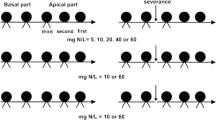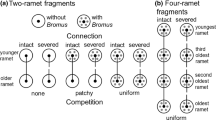Abstract
Clonal fragments of Glechoma hederacea L. (Lamiaceae) were subjected to environments in which light and nutrients were supplied with a strictly negative association in space, i.e. when one of these resources was in ample supply the other was scarce. Treatments were chosen to simulate environments in which clones grew either within homogeneous conditions or across patch types (heterogeneous conditions). The hypothesis was tested that reciprocal translocation (i.e. exchange of both nutrients and assimilates) between connected groups of ramets would increase biomass production of clones growing under heterogeneous conditions compared to that of clones growing in homogeneous conditions. A cost-benefit analysis was carried out to test this hypothesis. Results suggested that reciprocal translocation did not occur at the structural scale considered in this experiment; no evidence was found for a significant effect on whole clone biomass of assimilate and/or nutrient translocation between clone parts experiencing contrasting levels of resource supply. It is suggested that predominantly acropetal movement of resources and the pattern of integrated physiological unit formation in G. hederacea are the main properties responsible for the lack of mutual physiological support between connected clonal fragments growing in differing habitat conditions. These properties are expected to promote clonal expansion and the exploitation of new territory, rather than sustaining clone parts in sub-optimal patches of habitat for prolonged periods of time.
Similar content being viewed by others
References
Alpert P (1991) Nitrogen sharing among ramets increases clonal growth in Fragaria chiloensis. Ecology 72: 69–80
Alpert P, Mooney HA (1986) Resource sharing among ramets in the clonal herb Fragaria chiloensis. Oecologia 70: 227–233
Birch CPD, Hutchings MJ (1992a) Analysis of ramet development in the stoloniferous herb Glechoma hederacea using a plastochron index. Oikos 63: 387–394
Birch CPD, Hutchings MJ (1992b) Stolon growth and branching in Glechoma hederacea L.: an application of a plastochron index. New Phytol 122: 545–551
Birch CPD, Hutchings MJ (1994) Exploitation of patchily distributed soil resources by the clonal herb Glechoma hederacea. J Ecol 82: 653–664
Caraco T, Kelly CK (1991) On the adaptive value of physiological integration in clonal plants. Ecology 72: 81–93
Eriksson O, Jerling L (1990) Hierarchical selection and risk spreading in clonal plants. In: van Groenendael J, de Kroon H (eds) Clonal growth in plants: regulation and function. SPB Academic, The Hague, pp 79–94
Evans JP (1991) The effect of resource integration on fitness related traits in a clonal dune perennial, Hydrocotyle bonariensis. Oecologia 86: 268–273
Evans JP (1992) The effect of local resource availability and clonal integration on ramet functional morphology in Hydrocotyle bonariensis. Oecologia 89: 265–276
Evans JP, Whitney S (1992) Clonal integration across a salt gradient by a nonhalophyte, Hydrocotyle bonariensis (Apiaceae). Am J Bot 79: 1344–1347
Friedman D, Alpert P (1991) Reciprocal transport between ramets increases growth of Fragaria chiloensis when light and nitrogen occur in separate patches but only if patches are rich. Oecologia 86: 76–80
Hartnett DC, Bazzaz FA (1983) Physiological integration among intraclonal ramets in Solidago canadensis. Ecology 64: 779–788
Hartnett DC, Bazzaz FA (1985) The integration of neighbourhood effects by clonal genets of Solidago canadensis. J Ecol 73: 415–427
Headley AD, Callaghan TV, Lee JA (1988a) Phosphate and nitrate movement in the clonal plants Licopodium annotinum L. and Diphasiastrum complanatum (L.) Holub. New Phytol 110: 487–495
Headley AD, Callaghan TV, Lee JA (1988b) Water uptake and movement in the clonal plants Licopodium annotinum L. and Diphasiastrum complanatum (L.) Holub. New Phytol 110: 497–502
Hewitt EJ (1967) Sand and water culture methods used in the study of plant nutrition (Technical Committee 22). CAB, Farnham Royal, Bucks
Lau RR, Young DR (1988) Influence of physiological integration on survivorship and water relations in a clonal herb. Ecology 69: 215–219
Marshall C (1990) Source-sink relations of interconnected ramets. In: van Groenendael J, de Kroon H (eds) Clonal growth in plants: regulation and function. SPB Academic, The Hague, pp 23–41
Pate JS (1980) Transport and partitioning of nitrogenous solutes. Annu Rev Plant Physiol 31: 313–340
Pate JS (1983) Patterns of nitrogen metabolism in higher plants and their ecological significance. In: Lee JA, McNeill S, Rorison IH (eds) Nitrogen as an ecological factor. Blackwell, Oxford, pp 225–255
Pitelka LF, Ashmun JW (1985) Physiology and integration of ramets in clonal plants. In: Jackson JBC, Buss LW, Cook RE (eds) Population biology and evolution of clonal organisms. Yale University Press, New Haven, pp 399–437
Price EAC, Hutchings MJ (1992) The causes and developmental effects of integration and independence between different parts of Glechoma hederacea clones. Oikos 63: 376–386
Price EAC, Marshall C, Hutchings MJ (1992) Studies of growth in the clonal herb Glechoma hederacea. I. Patterns of physiological integration. J Ecol 80: 25–38
Salzman AG, Parker MA (1985) Neighbours ameliorate local salinity stress for a rhizomatous plant in a heterogeneous environment. Oecologia 65: 273–277
SAS Institute (1988) SAS/STAT Guide for personal computers. release 6.03. SAS Institute, Cary
Schlesinger WH, Reynolds JF, Cunningham JF, Huenneke LF, (1990) Biological feedbacks in global desertification. Science 247: 1043–1048
Slade AJ, Hutchings MJ (1987a) The effects of nutrient availability on foraging in the clonal herb Glechoma hederacea. J Ecol 75: 95–112
Slade AJ, Hutchings MJ (1987b) An analysis of the costs and benefits of physiological integration between ramets in the clonal perennial herb Glechoma hederacea. Oecologia 73: 425–431
Slade AJ, Hutchings MJ (1987c) Clonal integration and plasticity in foraging behaviour in Glechoma hederacea. J Ecol 75: 1023–1036
Slade AJ, Hutchings MJ (1989) Within- and between-population variation in ramet performance in the gynodioecious clonal perennial herb Glechoma hederacea. Can J Bot 67: 633–639
Sokal RR, Rohlf FJ (1981) Biometry, 2nd edn. Freeman New York
Stuefer JF, During HJ, Kroon H d (1994) High benefits of clonal integration in two stoloniferous species, in response to heterogeneous light environments. J Ecol 82: 511–518
Watson MA (1986) Integrated physiological units in plants. Trends Ecol Evol 1: 119–123
Watson MA, Casper BB (1984) Morphogenetic constraints on patterns of carbon distribution in plants. Annu Rev Ecol Syst 15: 233–258
Author information
Authors and Affiliations
Rights and permissions
About this article
Cite this article
Stuefer, J.F., Hutchings, M.J. Environmental heterogeneity and clonal growth: a study of the capacity for reciprocal translocation in Glechoma hederacea L.. Oecologia 100, 302–308 (1994). https://doi.org/10.1007/BF00316958
Received:
Accepted:
Issue Date:
DOI: https://doi.org/10.1007/BF00316958




